On the surface, Hiroshima, Japan, was like any other large metropolitan city. Traffic streamed down the broad boulevards. Trams trundled noisily past on tracks set in the middle of the street. People hurried along sidewalks under a searing sun. Yet from the moment I set foot in Hiroshima, I felt wrapped in a cloak of peace.
War leaves its marks on cultures as firmly as it does on individuals. The devastation suffered from the A-bomb that was dropped on Hiroshima at the end of WWII might easily have left the Japanese a bitter, resentful, war-mongering people. Instead, they have become the nation most passionately devoted to nuclear disarmament and world peace.
This quest for peace pervades everyday life in Japan. On the Limousine Bus from the Airport, an announcement instructed that mobile phones be set to quiet mode. The hour-long ride was eerily silent, without a single phone ringing or word being uttered. Passengers on trolleys are prohibited from talking on their cell phones or playing music. In other destinations around the world, I endlessly wait for crowds to clear so I can take a decent photo. But at the eternal flame and Atomic Bomb Dome in Hiroshima, Japanese tourists queued automatically, patiently waiting for their turn to pay respects or snap a photo.

The Atomic Bomb Dome sits just a few hundred meters from the hypo-center of the devastating nuclear blast. The bomb was detonated 600 meters above the ground to cause the maximum possible destruction. A conference was underway in the building that day; everyone in attendance was instantly incinerated. Thousands of children who were in the city center, helping to tear down old wooden buildings to create fire breaks, were also killed. Almost everything within a three-mile radius was flattened. Remarkably, the Atomic Bomb Dome survived. Once the mushroom cloud cleared, it’s badly damaged shell was one of very few structures still standing in a sea of debris. The building was so loved that it was decided not to raze it. After the war it was stabilized and has served as a peace memorial ever since.
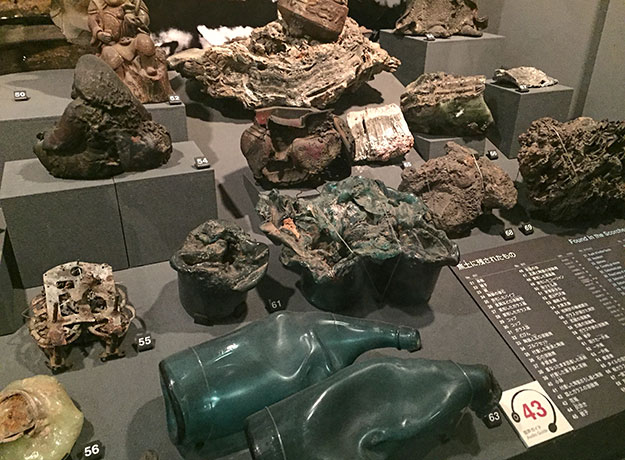
One rainy day I visited the Peace Museum, located across the river from the Atomic Bomb Dome. Outside, Japanese school children walked two-by-two in orderly lines, or sat cross-legged and mute, waiting for their turn to enter. Never have I witnessed such well-behaved children. Inside, I moved slowly through the darkened exhibit rooms, viewing tattered clothing, twisted tricycles, and scores of artifacts that had been rendered almost unrecognizable by the bomb. The crowd that day was shoulder-to-shoulder, but the only sounds were heavy sighs and the occasional gasp.
I came away from the museum shaken, but more impactful was a talk given later that same afternoon by a woman whose mother was a survivor of the bomb. Her mother was at home that day and since the family lived more than three kilometers from the hypo-center, she was not harmed. Her mother’s sister, however, had gone into the city center that morning. Two days later, the family found her in a makeshift hospital on a nearby island. Blind, covered in burns, and virtually unrecognizable, she cried out when she heard her sister’s voice. Her injuries were too severe; she died the following day.
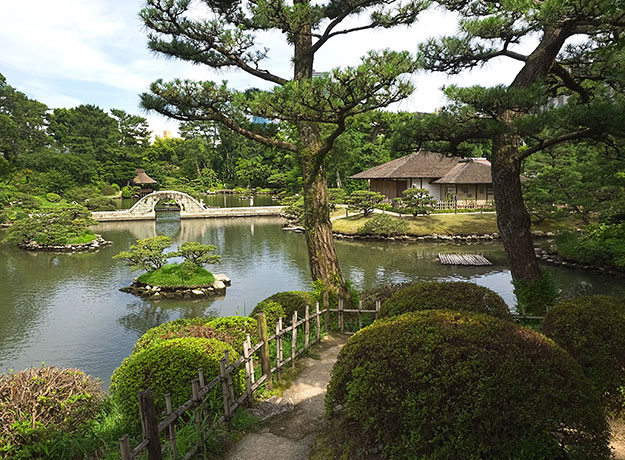
Seeking escape from the oppressive July heat, on my final day in Hiroshima I escaped to Shukkei-en Garden. A lake shore path meandered through exquisitely manicured gardens to a red lacquered bridge, where a kimono-clad couple stood holding hands. They gazed into each other’s eyes lovingly, smiling shyly for the photographer taking their wedding photos. Not wishing to disturb, I stood back and watched, drinking in the peaceful scene. After spending six days in the city, I chose the three words that best describe Hiroshima: peaceful, quiet, and orderly.
Three words that best describe Hiroshima: peaceful, quiet, and orderly
Miyajima island, just an hour away from Hiroshima proper, added the element of spirituality to the theme of peace. Officially named Itsukushima, the island is more commonly referred to as Miyajima, which in Japanese translates to “shrine island.” I visited on a day trip and within minutes of stepping off the ferry, I was surrounded by tame deer who nosed my pockets for food. Dodging the pesky deer, I strolled a short distance along the beach to Itsukushima Shrine, a collection of vermilion lacquered pavilions, prayer halls, and stages connected by wooden boardwalks.

The shrine is believed to have been constructed in 593, however the first written reference to it appeared in a list of Japan’s most famous shrines dated 811. Its fame grew when the Imperial Court began to take notice in the 12th century. Restoration work after fires and a typhoon in the 13th and 14th centuries changed the layout of the shrine, but since 1325 Itsukushima has not changed. Today, largely due to the presence of Itsukushima Shrine and its Torii Gate, the sacred island of Miyajima is ranked as one of the three most scenic sites in Japan.
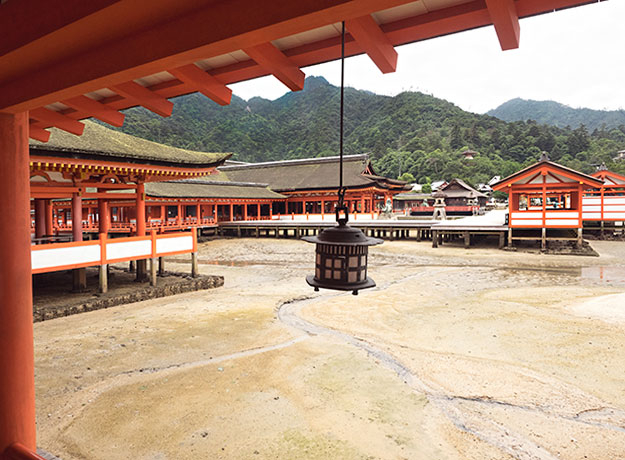
Built upon pilings driven into the sea bed, the shrine seems to float on the water at high tide. Out in the bay, the Torii Gate stands on immense wood pillars topped by a delicately curved header. More than the shrine itself, visitors from around the world come to see the red-lacquered portal, said to be the spiritual entrance to the temple. At low tide, people walk out to the exposed base and press coins into its legs for good fortune. When the incoming tide floods washes over the the massive pillars, the Torii Gate also appears to be floating on the sea.
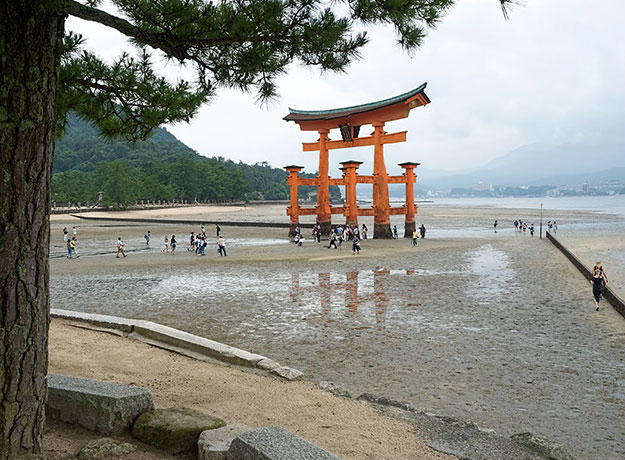
No one knows for sure why the structures were built over the water rather than on protected dry land. Some say it was because the enshrined deity is goddess of the sea. Others insist it has to do with the Buddhist belief of Pure Land, which says that the souls of those who die cross to the next world on boats. I stood on the Great Stage at the center of the shrine and gazed out at the Torii Gate as slate-gray seas rushed in. Even the leaden clouds and stingy sunlight couldn’t lessen the impressive sight. It was easy to make my list of three words for Miyajima Island: spiritual, natural, serene.
Three words for Miyajima Island: spiritual, natural, serene
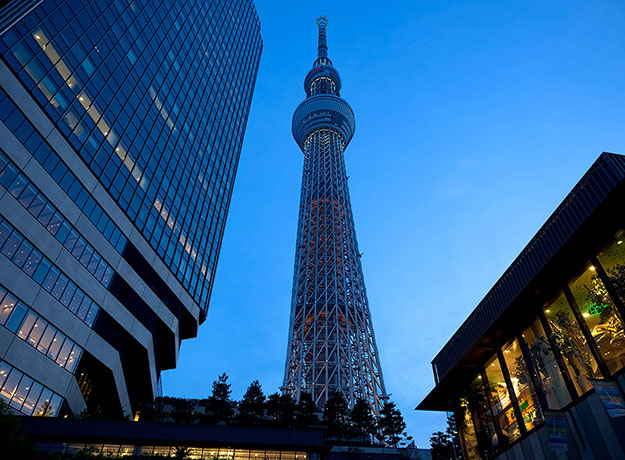
The fast-paced, high-tech, no holds barred atmosphere of Tokyo couldn’t have been more jarring after my time in Hiroshima and Miyajima. Just figuring out how to use the Metro system in Tokyo was a challenge. But even more difficult was deciding what to do in Tokyo during the short time I had available. From the traditional Tsujiki Fish Market, through which 2,000 tons of seafood pass every day, I moved to the Shiodome district, where I watched the giant cuckoo-clock on the face of the Nippon TV glass skyscraper perform its shenanigans. On the 43rd floor of the Shiodome City Center, I took in a free view over the city that was every bit as good as the pricey ride to the top of Tokyo Skytree. Just a few short blocks from the glitzy Skytree stood Senso-ji, the oldest temple in Tokyo.

I was whisked between ancient temples on speeding Metro bullets. To reach Hama-rikju Park on Tokyo Bay I braved a searing sun and nightmare traffic that zipped by just inches from the sidewalk. But beyond the entrance lay a tranquil world of birds chirping and crystal streams burbling through Japanese gardens. Frazzled by my dash from place to place, I retreated to the tea house in the center of the lake in Hama-rikju Park and whiled away a delightful hour over Matcha tea and sweet dumplings.
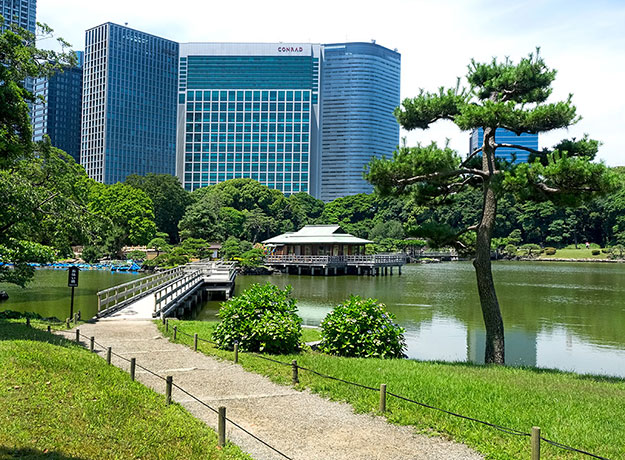
The entire time in Tokyo, I wavered between astonishment and exhaustion. It would have taken a year to see everything the city had to offer. By the end of my fourth day, I was ready to escape to Kyoto, but not before choosing the three words that best defined Tokyo for me: paradoxical, fast-paced, diverse.

Three words that defined Tokyo for me: paradoxical, fast-paced, diverse
The following day I made my way through Tokyo Station to the Shinkansen Train that would speed me to Kyoto. When my train arrived at 17 minutes before noon, I politely waited for passengers to disembark and then tried to board, but a bucket-carrying woman dressed in a pink uniform motioned for me to wait. Other cleaners carried boxes of trash out of the train and off the platform. Inside the train, the woman stripped all the white linen headrest protectors off the seats and began turning all the seat around so they would be facing forward for the return journey. Others swept and vacuumed the aisles while the pink-uniformed woman placed fresh, clean headrest protectors on every seat.
It was 11:55 and the train was scheduled to leave at noon, yet the doors were still closed. Cleaning continued until exactly 11:57, when the doors were opened and all the passengers filed in. I wouldn’t have believed it possible, but our train pulled out of the station at the stroke of noon. Two and a half hours later I was in Kyoto, having traveled much of the way at 200 mph.

Unlike my other destinations in Japan, where I had stayed in vacation rental apartments and hotels, in Kyoto I decided to try out a traditional Japanese Ryokan. I chose Kyoto Yoshimizu Inn for its location, tucked high in the hills of Maruyama Park on the eastern edge of Kyoto. Their description sounded like pure bliss: “Surrounded by nature, with Higashiyama’s bamboo grove in the back, cherry blossoms in the front, and Chion-in Temple’s bell next door.”
Yoshimizu Inn was a charmingly dilapidated, yet warm and welcoming old wooden house. I sank into the overstuffed sofa and sipped on green tea while my host reviewed the best things to do in Kyoto. In my room, I took in the sliding paper panels and floors covered in tatami mats, noting that there was no bed in sight. My host soon cleared up the confusion, leading me to a closet where thick futons and duvets were stacked up. “You will make up your own bed on the floor,” he explained. “Move the furniture around however you please.”
My poor hip groaned at the prospect, but I piled two futons on top of one another and slept relatively comfortably. Whatever aches and pains ensued from sleeping on the floor were soaked away each night in their traditional Japanese tubs. After immersing up to my chin in deliciously hot water, I donned the Yukata that had been provided to me upon arrival. I fastened it securely with the wide Obi belt and shuffled around in the soft slippers that were also provided. In a word, it was wonderful.

Yoshimizu Inn was also ideally located within walking distance of several of the most important and historic sites in Kyoto. On my first of two days, I wandered up and down the gentle hills, popping into Shinto shrines and Buddhist temples. At Chion-in Temple, I spent a relaxing hour listening to the soothing chants of monks reverberate through the prayer hall. After tea in the garden at Shoren-in Temple, I climbed the preserved Japanese streets of Sannen-zaka and Ninen-zaka streets to the magnificent Kiyomizu-dera Temple.
Japanese women dressed in silk Kimonos or more causal cotton Yukata hobbled up the steep stone streets beside me. Though many Japanese still dress in traditional garb every day, it was obvious that these visitors were struggling in the narrow skirts and wooden clogs. By the end of the day, many were in obvious pain. I later learned that a cottage industry has grown up around the rental of Kimonos and Yukata. Japanese and foreign tourists alike can rent an entire outfit for the day. These stores even offer the services of a photographer who will follow you around all day, taking pictures at all the most important sites.

Though my host had recommended visits to temples on the west side of town as well, I chose to spend the second full day wandering around the city center. That was probably the only mistake I made when visiting Japan. The city center of Kyoto has little to recommend it. The architecture is boring, there little of interest to see, and even the touted Pontocho Alley is just a touristy street of restaurants and nightclubs. My three words for Kyoto? touristy, traditional, and historic.
My three words for Kyoto? Touristy, traditional, and historic.
In retrospect, visiting Japan in two weeks was overly ambitious and slightly insane. Kyoto, which had been so highly recommended to me by so many, was the least favorite of my four destinations. Hiroshima, where everyone said I was spending too much time, turned out to be my favorite. There are so many more things I would like to have seen. But as always, this too-brief stay whetted my appetite and made me anxious to return. The only problem will be in deciding where to go and how long to stay next time. I suspect it would take months, if not years, to see everything Japan has to offer. But that just makes it all the more intriguing.

A great choice of cities to cover within two weeks in Japan. Sorry you found Kyoto (my dream place to call home) to be the least attractive. Hope you will return for another Kyoto stay. Skip downtown Sanjo-Shijo Kawaramachi and head north to Kitayama+O\’hara or west to Arashiyama+ Takao to enjoy total bliss. Kyoto\’s city planning, preservation of nature and history and above all the civility of its people are unmatched.
Your \”charmingly dilapidated\” quite describe Japanese \’Wabi-sabi\’ aesthetics. Imperfection can be beautiful; in a transient world, there is indeed no time to waste…
Hi Patrick: I agree with you that Kyoto needs more examination on my part. There was so much to do there that I really only scratched the surface. I only had time to visit the temples on the east side of the city, as well as the city center. I understand there are some magnificent temples on the west side. I do hope to go back and explore more someday.
Your comments about Japan were well worth reading. I have been to Japan but went to Sapporo and a small town north of there. Stayed for 10 days in a fellow teacher’s house. It was on an exchange between two schools – one in BC and one in Japan. Loved my visit – it was in February and there was so much snow that year.
Hi Irene: I would love to go back to Japan and explore some more. I can just imagine that it is magical in the winter, but not sure I could stand the cold 🙂
Beautiful captured moments in both photos and words. I have been before but in a few weeks I’m taking my mother with me. Your descriptions made me excited to show her the wonders of Japan.
Thanks so much for sharing that Ashley. Your comment warmed my heart – it means what I do has worth.
I made the same four stop, two week trip with my 9 year old son in March. You summed up our experience perfectly. All travellers should put it on their bucket list. Fabulous country in which to travel.
It is, Brendan. And now that I’ve been gone a few weeks, I’m remembering my experience even more fondly. Japan is one country I definitely want to see more of.
So beautiful, and with such history, a real pleasure to read, and whets my appetite to travel there.
Sharon
Thanks Sharon – that’s a high compliment for a travel writer.
What a delightful, always different, account of your adventures in Japan (I learnt a great deal!). I absolutely loved the whimsical Really Big Clock ~ such a contrast to the high-tech Nippon TV building behind it. Thank you.
Thanks so much Alison. I also thought the big “cuckoo clock” was a bit strange, but I loved the performance it put on.
Barbara,
I have bad news.
The chances that the “geishas” you took are geishas are slim to none…
Here is a tip:
– If the geisha is strolling casually with friends, in the middle of the afternoon, stopping for tourists to take pictures and such, they also are tourists who are dressed up as geishas (there’s a whole business around that in Higashiyama especially).
– If the geisha is walking quickly in small streets (and not any small street, but in a hanamachi: Gion, Ponto-cho, Shiragawa-cho, Kamishichiken), at dusk, ignoring everyone around her and especially tourists, then you’re pretty sure she’s a geisha.
🙂
Hi David: Thanks so much for your information. It actually makes me think that maybe they were real Geishas. They did not seem particularly happy to pose for my photo. They did happily stop to talk to a gaggle of laughing schoolgirls, though, so who knows In any case, I was delighted to see them.
Japan is pretty beautiful.. I am also impressed by the well planned cities and gardens. Above all, Barbara’s camera produces ‘indescribable shots’. I am impressed with your ability to capture scenes..
Thank you SO much, Kafigi. What a lovely compliment.
Really enjoyed your Japan blog. Blessings, Paul
Hi Barbara, After reading about your delightful, descriptive, days in Japan, I want to go. You did a wonderful job enticing my senses and curiosity. Bravo, miss you always, Patti
Been thinking about you so much, Patti. Really miss you too. If I do return to Japan at some point, you’re always welcome to come with me. Hugs and much love to all three of you 🙂
Thank you SO much Paul.It always makes my day when people tell me they actually read the words over which I sweat blood 🙂